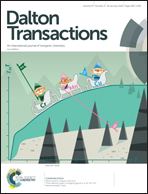Photophysical dynamics of the efficient emission and photosensitization of [Ir(pqi)2(NN)]+ complexes†
Abstract
The photophysical dynamics of three complexes in the highly-emissive [Ir(pqi)2(NN)]+ series were investigated aiming at unique photophysical features and applications in light-emitting and singlet oxygen sensitizing research fields. Rational elucidation and Franck–Condon analyses of the observed emission spectra in nitrile solutions at 298 and 77 K reveal the true emissive nature of the lowest-lying triplet excited state (T1), consisting of a hybrid 3MLCT/LCIr(pqi)→pqi state. Emissive deactivations from T1 occur mainly by very intense, yellow-orange phosphorescence with high quantum yields and radiative rates. The emission nature experimentally verified is corroborated by theoretical calculations (TD-DFT), with T1 arising from a mixing of several transitions induced by the spin–orbit coupling, majorly ascribed to 3MLCT/LCIr(pqi)→pqi and increasing contributions of 3MLCT/LLCTIr(pqi)→NN. The microsecond-lived emission of T1 is rapidly quenched by molecular oxygen, with an efficient generation of singlet oxygen. Our findings show that the photophysics of [Ir(pqi)2(NN)][PF6] complexes is suitable for many applications, from the active layer of electroluminescent devices to photosensitizers for photodynamic therapy and theranostics.
![Graphical abstract: Photophysical dynamics of the efficient emission and photosensitization of [Ir(pqi)2(NN)]+ complexes](/en/Image/Get?imageInfo.ImageType=GA&imageInfo.ImageIdentifier.ManuscriptID=C7DT03930A&imageInfo.ImageIdentifier.Year=2018)


 Please wait while we load your content...
Please wait while we load your content...